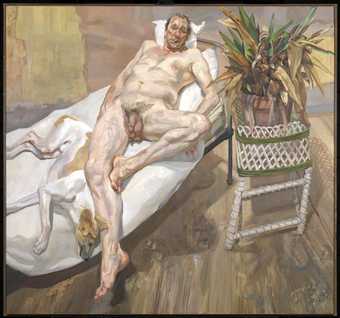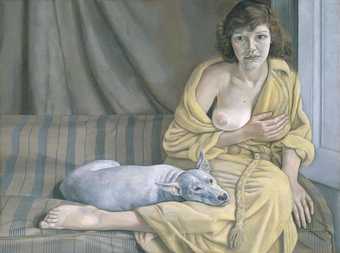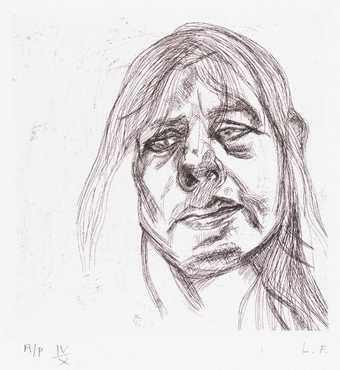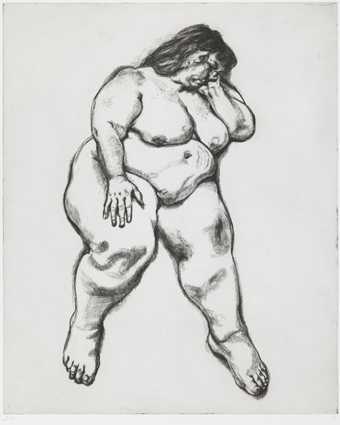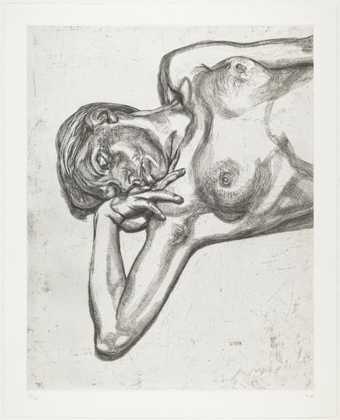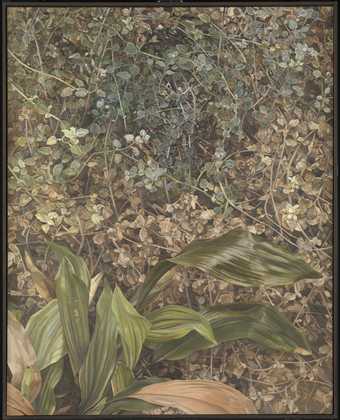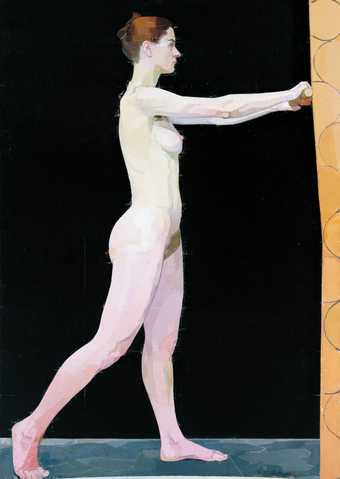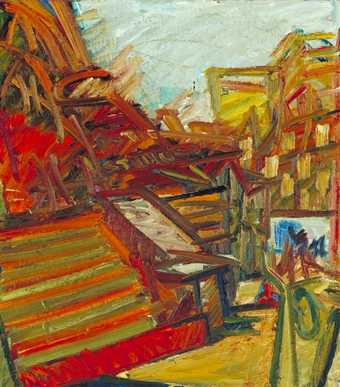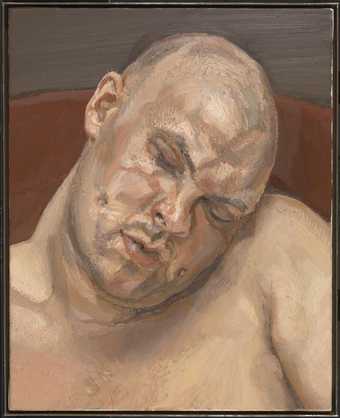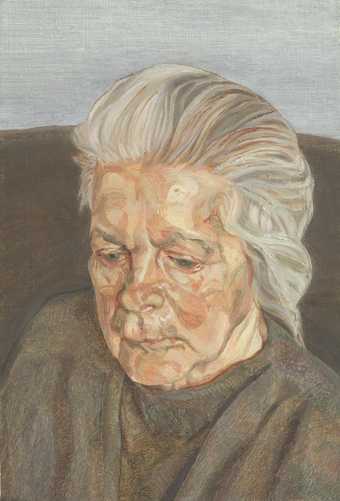
Not on display
- Artist
- Lucian Freud 1922–2011
- Medium
- Oil paint on canvas
- Dimensions
- Support: 1689 × 1384 mm
frame: 1810 × 1505 × 84 mm - Collection
- Tate
- Acquisition
- Purchased with assistance from the Art Fund, the Friends of the Tate Gallery and anonymous donors 1990
- Reference
- T05722
Summary
Purchased with assistance from the National Art Collections Fund, the Friends of the Tate Gallery and anonymous donors 1990
T05722
Since the 1960s the nude has been an important theme in Lucian Freud's work. The intense attention to the particularities of each body has led some critics to place these pictures in a tradition of realist nudes, which begins with the paintings of Gustave Courbet (1819-77). While many have commented on the disturbing accuracy of Freud's figure painting he himself has argued for 'truthfulness as revealing and intrusive, rather than rhyming and soothing' (quoted in Lucian Freud Painting and Etchings, exhibition catalogue, Abbot Hall Art Gallery, Kendal 1996, p.10). Intense scrutiny rather than idealisation is an important theme within Freud's work.
Like many of Freud's pictures Standing by the Rags was painted in his London studio. The motif of the mound of rags first appeared in Red Haired Man 1962-3 (Erich Sommer Collection) but only became commonly recurrent during the late 1980s. The rags, which are in fact heaped in front of a hidden radiator, are used by Freud for wiping brushes and have been interpreted by some critics as a coded sign for the artist's presence in the image. Jeremy Lewison has compared the smeared paint on the rags to blood and other bodily secretions.
The degree of attention given to the detail and texture of the rags is equivalent to that given to the figure. The shallow spatial depth of the picture makes it difficult to tell whether the woman is standing against or lying on the rags. She is positioned with one arm at her side and the other raised. Her head is twisted so that it rests on her right shoulder. Although the model was asked to find a pose that would be comfortable for her to hold over long periods, it nonetheless seems awkward. Lewison has compared it to that of the female figure in Ingres' Angelica Saved by Ruggiero (National Gallery Collection, London), a painting that Freud included in 'The Artist's Eye' exhibition held at the National Gallery in 1987. The pose is also reminiscent of the figure of Christ being lowered from the Cross in old master paintings of the Deposition.
The paint has been applied with a stiff hog-hair brush to create a textured appearance for the whole painting. The model's face, breasts and genitalia are rendered in a particularly thick impasto, which heightens their physical presence within the overall scheme. The physicality of the model is further enhanced by the warm, dark palette used for her body compared to the cool tones of the rags. In contrast to the ivory smoothness of a classical nude, the flesh of Freud's model is sagging, mottled and flushed.
Standing by the Rags is one of Freud's largest paintings of the nude. Unusually it re-appears in the background of another painting, Two Men in the Studio 1987-9 (private collection, reproduced Lampert, p.109. cat.no.47 in colour). In that painting a male nude is shown standing on a mattress with his hands behind his head while another man lies under the bed sheets. Behind these two figures and to the left is Standing by the Rags and to the right the actual mound of rags depicted in the painting.
Further reading:
Bruce Bernard and Derek Birdsall (eds.), Lucian Freud, London 1996, reproduced p.273, pl.231 (colour)
Catherine Lampert, Lucian Freud, Recent Work, exhibition catalogue, Whitechapel Art Gallery, London 1993, reproduced p.113, cat.no.49 (colour)
Jeremy Lewison, 'Lucian Freud's 'Standing by the Rags', National Art Collections Fund Review 1990, 1990, pp.91-3
Toby Treves
March 2000
Does this text contain inaccurate information or language that you feel we should improve or change? We would like to hear from you.
Display caption
The female nude has been Freud’s main theme for years. Critics have linked his work to the tradition of realism, but he pointed out ‘there is a distinction between fact and truth. Truth has an element of revelation about it.’Like William Coldstream’s paintings also shown in this room, Freud reminds us that this woman is standing in his studio. The rags piled behind her are those he uses to clean his brushes. They introduce an idea of dirtiness, perhaps even bodily secretions. He may be suggesting there is more to a truthfully represented body than its appearance.
Gallery label, May 2007
Does this text contain inaccurate information or language that you feel we should improve or change? We would like to hear from you.
Technique and condition
The canvas is relatively fine for a painting of its size and bears a similarly thin white ground layer which the artist remembered in 1991 as being Ripolin emulsion paint. The stretcher is unusually robust and was made by Philip Watkins.
The initial drawing on the white ground is in charcoal. Subsequently applied paint is heavily brushmarked and of significant thickness. The artist found it necessary to key-out the stretcher to maintain an acceptable degree of canvas tension during the extended period of painting. The artist regularly used artists' oil tube paints from Winsor & Newton, from Rowneys and occasionally Schmincke at this time.
The painting is not varnished and the artist regards the glass or acrylic glazing in a frame as serving a similar function to a varnish. Freud selected the present frame which had already been fitted with acrylic glazing at the time of Tate accession in 1990. The painting was in good condition at this time and needed no direct treatment other than improvements to its security in the frame.
Peter Booth
1994
Explore
- emotions, concepts and ideas(16,416)
-
- formal qualities(12,454)
-
- texture(466)
- workspaces(918)
-
- studio(549)
- miscellaneous(732)
-
- cloth(83)
- actions: postures and motions(9,111)
-
- arm / arms raised(839)
- standing(3,106)
- woman(9,110)
- female(1,681)
You might like
-
Lucian Freud David and Eli
2003–4 -
Lucian Freud Girl with a White Dog
1951–1952 -
Lucian Freud Head of a Woman
1982 -
Lucian Freud Woman Sleeping
1995 -
Lucian Freud Kai
1992 -
Lucian Freud Man Posing
1985 -
Lucian Freud Blond Girl
1985 -
Lucian Freud Head and Shoulders of a Girl
1990 -
Lucian Freud Naked Portrait
1972–3 -
Lucian Freud Two Plants
1977–80 -
Euan Uglow Zagi
1981–2 -
Frank Auerbach To the Studios
1990–1 -
Lucian Freud Leigh Bowery
1991 -
Lucian Freud The Painter’s Mother IV
1973 -
Lucian Freud Girl in a Striped Nightshirt
1983–5

